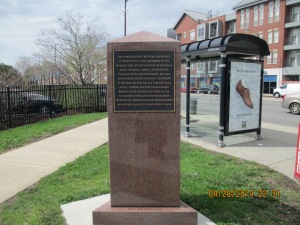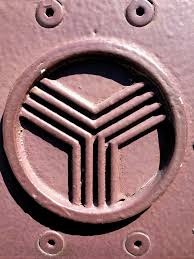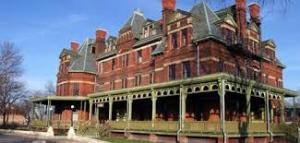Our Chicago—People You Should Know
Chicago has a large number of people who have made Chicago a great city. Some of the people you will learn about are still living and others lived here in the past. Some of the people are businessmen and politicians, others are community leaders, and still others are artists and musicians.
Daniel Hale Williams (1858-1931)
An important member of the African-American community in the 1890s, Daniel Hale Williams was one of the best-known physicians in the country. Williams was responsible for creating the first nursing school for African-American women in Chicago and for founding Provident Hospital. This hospital, now under the direction of Cook County Hospital, was the important provider of healthcare services to the African-American community at a time when there were no such facilities in the city. Williams is best known for being the first surgeon to perform open-heart surgery.
Marshall Field (1834-1906)
Marshall Field was the founder of the famous Chicago department store that is named for him. Born in Massachusetts in 1834, Field worked his way up in retailing and in 1868, with his partner, Levi Leiter, opened their own department store. Considered one of the world’s great places to shop, Field’s is known for its service and emphasis on customer satisfaction. Marshall Field was also famous for his civic activities and gifts of charity. He, along with George and Philip Danforth Armour, contributed money to Dr. Daniel Hale Williams for the construction of Provident Hospital.
Potter Palmer (1826-1902)
Palmer came to Chicago from New York with experience operating a dry-goods business. He opened such a store on Lake Street and was very successful. He later sold the store to Field and Leiter and turned to real estate. Palmer is responsible for making State Street the commercial center that it is today. One of the most notable buildings he built on State Street is the Palmer House Hotel, known for its elegance and charm. But in 1871, the hotel and everything else on State Street was destroyed by the Great Fire. Not discouraged, Potter borrowed money and rebuilt State Street and a new, more impressive Hotel. It was also the first fireproof hotel.
Ida B. Wells Barnett
Ida B. Wells was the most successful and most famous black female journalist in the country in her day. In her newspaper, Free Speech, she detailed the racial injustices that blacks endured in Memphis, Tennessee. After her story appeared describing the lynching of three black prisoners, the mob broke into Wells’ newspaper offices and destroyed the printing equipment and all the copies of the newspaper they could find. Ms. Wells continued to publicize the facts of lynching while working for the New York Age. She led an appeal to President William McKinley for support in fighting this horrible practice. A native of Mississippi, Wells came to Chicago and married a newspaper journalist, Ferdinand Barnett in 1895. They worked together fighting injustice. Wells was one of the original organizers of the national conference out of which grew the N.A.A.C.P (National Association for the Advancement of Colored People).
Bessie Coleman (1893-1926)
The daughter of a Texas sharecropper, Bessie Coleman came to Chicago after finishing high school. In Chicago she trained to become a hair stylist and manicurist, but she developed a fascination for airplanes and flying. She wanted to become a pilot, but because women and especially black women were not allowed to get a license in the U.S. Bessie went to France, where she learned to fly from French Red Cross pilots. She came back to the United States in 1921 and was trying to establish a flight school for blacks. In order to make money, Bessie began touring with air shows as a stunt flyer. Her dream of opening the flight school failed when she died in an air crash. She was the first African-American woman to earn an international pilot’s license.
Richard J. Daley (1902-1976)
Richard J. Daley ran Chicago as mayor for 21 years, from 1955-1976, longer than any other mayor in Chicago history. Daley was effective because he forged a coalition of working class, middle class, white ethnics and African-Americans. A life-long resident of Bridgeport, Daley attended DePaul University. He worked his way up in politics from precinct captain to clerk in the city council to the state senate. As mayor, Daley initiated many public works projects to improve life in the city, including the construction of O’Hare Airport, the development of the expressway system, and important urban renewal projects in Hyde Park and other neighborhoods. Daley will always be remembered for his tough policies against riots and political demonstrations.
Margaret Taylor Goss Burroughs
Dr. Margaret Burroughs is the principal founder of the DuSable Museum of African-American History. She started the museum in her home and now it is one of the foremost American institutions preserving the culture and history of African-Americans. Dr. Burroughs studied art at the School of the Art Institute of Chicago. She also taught art at DuSable High School for 23 years. She is known the world over for her paintings and also for her writing. In addition to writing children’s books, she has written several books of poetry. The poem “What Shall I Tell My Children Who Are Black?” is read all over the world.
Lorraine Hansberry
Born in Chicago in 1930, Ms. Hansberry is the first African American woman to have a play produced on Broadway in New York City. The play, A Raisin in the Sun, is a drama about a poor African-American family that dreamed of a better life. The play won the New York Drama Critics Circle Award in 1959. Later it was made into a film and also into a musical. Ms. Hansberry completed another major drama before her death called The Sign in Sidney Brustein’s Window in 1964. Ms. Hansberry was deeply committed to the struggle for human rights for African-Americans. She died in 1965.
Studs Terkel
Studs Terkel is known as a historian and writer. He writes about people’s lives. Born in Chicago in 1912, Stud’s best-selling books include Hard Times (1970), Working (1974), Race (1992). He won a Pulitzer Prize for The Good War in 1985. For many years he worked as a radio interviewer on a one-hour show for the station WFMT. His latest book, Coming of Age, features 70 people who have lived long lives. They discuss an important time and place in history. In addition to writing and interviewing people, Studs loves music, especially jazz. He worked as a disc jockey playing jazz and folk music for the Chicago listeners.
Gwendolyn Brooks (1917-2000)
Gwendolyn Brooks was Poet Laureate of Illinois. She won the Pulitzer Prize in 1950 for Annie Allen. She was the first African-American writer to win this famous award. She has authored many volumes of poetry, including A Street in Bronzeville, In the Mecca, Blacks, and a novel, Maud Martha. Brooks was named Consultant-in-Poetry to the Library of Congress from 1985-1986 and was the first African-American woman to be so honored. In May 1993, THE GWENDOLYN BROOKS CENTER FOR BLACK LITERATURE AND CULTURE was dedicated at Chicago State University. Brooks was Writer-in-Residence there. Gwendolyn Brooks is seen as one of the preeminent poets of the century. She was an inspiration to many young writers of poetry and to all who had the opportunity to hear her read her poetry.
Ramsey Lewis
Born in Chicago in 1935, Ramsey began playing piano at a very young age. He refined his talents by playing gospel music. Ramsey is famous for the trio named for him. His first big hit was “The In Crowd”, which reached number 5 in the U.S. music charts, selling over a million copies in 1965. Lewis has won 5 Grammy Awards and has 5 Gold Records. He has also had the great honor to perform at the White House.
Harold Washington (1922-1987)
During the campaign for mayor in 1982 many people were interested in the promise of government reform promised by Harold Washington. In 1983 he was elected as the first African-American mayor of the City of Chicago. During his term of office the city government was improved in many ways, not the least of which was increased government employment for minorities. Washington earned his law degree at Northwestern University in 1952 and served as a state representative and state senator from 1965-1981. In 1981, Harold was elected to the U.S. Congress. Washington will be remembered as a great Chicago mayor and for his speeches and his humor.
Luis Gutierrez
Congressman Luis Gutierrez is the first Latino to be elected to Congress from the Midwest. Elected in 1992, he has been an effective legislator and spokesman for the citizens he represents from the Fourth District in Illinois. Congressman Gutierrez has addressed the needs of the Latino community in promoting citizenship for immigrants. He was also instrumental in securing federal funding to reconstruct the aging Douglas Blue Line “L” route, which runs through his district.
Mr. Gutierrez was born in Chicago in 1953 and worked as a teacher, social worker, and community activist until his election to the Chicago City Council as alderman of the 26th Ward.
Carol Moseley-Braun
Carol Moseley-Braun, daughter of a Chicago law-enforcement officer, made history in November, 1992 when she became the first black woman to be elected to the United States Senate. She was the first woman and first African-American woman to hold office in Cook County government. In 1978, Moseley-Braun was elected to the Illinois House of Representatives. She was best known during her tenure in the house and later in the senate as a legislator who could build coalitions consisting of people of all races. After losing her bid for reelection to the Senate, Moseley-Braun became the ambassador to New Zealand.
Mike Royko
Mike Royko was a columnist at the Chicago Tribune. His witty column ran in hundreds of newspapers all over the country. He was known for his outspoken commentary on city and national politics. Another famous writing project was his book about big-city politics under the leadership of the late Mayor Richard J. Daley, called “Boss”. Mike died in April, 1997 at 64.
Can you add names to this list or suggest other famous Chicago people? If so, please comment.









